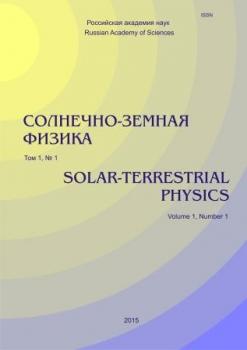Якутск, Россия
Якутск, Республика Саха (Якутия), Россия
Якутск, Республика Саха (Якутия), Россия
Якутск, Республика Саха (Якутия), Россия
Якутск, Республика Саха (Якутия), Россия
Впервые произведено разложение наблюдаемой анизотропии космических лучей на зональные гармоники и компоненты векторной и тензорной анизотропии. Рассмотрены события форбуш-понижений космических лучей, произошедших в ноябре 2001 г и ноябре 2004 г. Показано, что в начале форбуш-понижения преобладает конвекционный ток космических лучей, направленный от Солнца, а в период восстановления интенсивности — диффузионный ток частиц вдоль межпланетного магнитного поля в сторону Солнца. На фазах спада интенсивности космических лучей наблюдается кратковременное уменьшение величины второй зональной гармоники, которое совпадает с резкими скачками напряженности межпланетного магнитного поля и скорости солнечного ветра. Во время прохождения крупномасштабных возмущений солнечного ветра тензорная анизотропия ведет себя сложным образом, для объяснения ее поведения требуется дальнейшее детальное исследование.
космические лучи, тензорная анизотропия, форбуш-понижение, корональные выбросы массы
NATURE OF ANISOTROPY
An anisotropic flow of cosmic rays (CR), which is registered by ground-based detectors, is originated first of all from dynamic processes in the solar wind, which affect CR through the interplanetary magnetic field (IMF).
Notice that CR anisotropy also occurs outside the helio-sphere, but for the particles registered by ground-based CR detectors, the solar wind is the main modulation factor. The observed anisotropy can be presented by the first two spherical harmonics expressing themselves as diurnal variations due to the Earth rotation. In the angular coordinate system, with the polar axis parallel to the axis of the Earth rotation, the first spherical harmonic is presented as a component R11 . This component can be represented as a vector and is called vector anisotropy. R11 reflects a direct motion or current of CR. The current has a convective or diffusive origin. The convective current appears when CR move together with the solar wind magnetic field; and the diffusive current, due to CR gradients and their scattering by magnetic irregularities. In the steady state of the interplanetary medium, the convective current is directed away from the Sun; and the diffusive current, toward the Sun along IMF lines. In general, the diurnal anisotropy shows the moment of maximum intensity about 18 LT.
The tensor anisotropy components R22 and R12 in the above angular coordinate system appear as semidiurnal and antisymmetric diurnal variations. The reason for the observed anisotropy is a deficit of particles moving along field lines in loop structures of IMF. In average over the course of a long period, this component is presented, on the 12-hour dial, as a vector directed to 3 LT. The same anisotropy should appear in the presence of the heliolatitudinal CR gradient with minimum intensity near Earth’s heliolatitude. A deviation of magnetic tubes from the Archimedian spiral leads to a change of the R22 direction. The component R12 usually appears in the region of heliolatitudinal shift of the CR current. If the convective current shifts, then R12 is maximum at 12 or 0 LT. If there is a heliolatitudinal shift of the diffusive current along the field lines, the variation is maximum at 9 or 21 LT. In more complicated cases, when the convective and diffusive currents shift simultaneously and when field tubes are deviated, the tensor anisotropy behaves in a complicated way.
1. Abunina M., Abunin A., Belov A. Phase distribution of the first harmonic of the cosmic ray anisotropy during the initial phase of Forbush effects. J. Physics: Conference Ser. 2015, vol. 632, no. 012044.
2. Abunina M.A., Abunin A.A., Belov A.V. et al. Relationship between Forbush effect parameters and the heliolongitude of solar sources. Geomag-netism and Aeronomy. 2013, vol. 53, no. 1, pp. 10-18.
3. Altukhov A.M., Krymsky G.F., Kuzmin A.I. The method of “Global survey” for investigating cosmic ray modulation. Proc. 11th Int. Conf. on Cosmic Rays. 1970, vol. 4, pp. 457-460.
4. Belov A.V., Asipenka A., Dryn E.A., Eroshenko E.A. Kryakunova O.N., Oleneva V.A., Yanke V. Behavior of the cosmic-ray vector anisotropy before interplanetary shocks. Bull. RAS: Physics. 2009, vol. 73, no. 3, pp. 331-333.
5. Grigo-ryev V.G., Starodubtsev S.A., Krymsky G.F. Krivoshapkin P.A., Timofeev V.E., Prikhodko A.N., Karmodonov A.Ya. Modern Yakutsk spectrograph after A.I. Kuzmin. Proc. 32th Int. Conf. on Cosmic Rays. 2011, vol. 11, pp. 252-255. DOI:https://doi.org/10.7529/ICRC2011/V11/360.
6. Jian L., Russell C.T., Luhmann J.G., Skoug R.M. Properties of interplanetary coronal mass ejections at one AU during 1995-2004. Solar Phys. 2006, vol. 239, pp. 393-436. DOI:https://doi.org/10.1007/s11207-006-0133-2.
7. King J.H., Papitashvili N.E. Solar wind spatial scales in and comparisons of hourly Wind and ACE plasma and magnetic field data. J. Geophys. Res. 2005, vol. 110, A02104. DOI:https://doi.org/10.1029/2004JA010649.
8. Kravtsova M.V., Sdobnov V.E. Cosmic rays during great geomagnetic storms in cycle 23 of solar activity. Geomagnetism and Aeronomy. 2016, vol. 56, no 2, pp. 143-150.
9. Munakata K., Kuwabara T., Bieber J.W. et al. CME-geometry and cosmic-ray anisotropy observed by a prototype muon detector network. Adv. Space Res. 2006, vol. 36, pp. 2357-2362.
10. Zhang J., Richardson I.G., Webb D.F., Gopalswamy N., Huttunen E., Kasper J.C., Nitta N.V., Poomvises W., Thompson B.J., Wu C.-C., Yashiro S., Zhukov A.N. Solar and interplanetary sources of major geomagnetic storms (Dst≤-100 nT) during 1996-2005. J. Geophys. Res. 2007, vol. 112, A10102. DOI:https://doi.org/10.1029/2007JA012321.



















